Occupational Data: A Different Perspective on the Economy
How many lawyers are employed in Indiana? How many people are employed in high-tech jobs? What percentage of Indiana workers work in high- or middle-wage occupations? These are just a few of the questions that can be answered using occupational data collected by the Indiana Department of Workforce Development (IDWD) for the U.S. Bureau of Labor Statistics (BLS). IDWD collects occupational data through four different surveys: the Occupational Employment Survey (OES), the Current Population Survey's March Supplement, the Employment Cost Index and the National Compensation Survey.

According to OES data for 1998, Indiana has 2.9 million workers employed in 711 occupations, with a weighted average annual wage of roughly $27,682. The largest major category of occupations, titled Production, Construction, Operating, Maintenance and Material Handlers, includes 955,540 workers or 33.3% of the total workforce (see Figure 1).

Within this category, the top five occupations include fabricators, assemblers, truck drivers, laborers and repair personnel. All of these workers, plus those categorized under Clerical/ Administrative Support and Sales/ Sales Related, are employed in "middle-wage occupations," earning a weighted average of $25,218 per year in 1998 (see Table 1). Together, these middle-wage jobs make up 61% of Indiana's workforce.
Click on table to see larger version

Twenty-three percent of Hoosiers work in high-wage occupations and 16% work in low-wage occupations (see Figure 2). Of all Indiana workers, 5.5% work in managerial or administrative occupations and 17.6% work in professional/technical positions, both considered high-wage occupational groups. The average annual salary for high-wage occupations in Indiana is approximately $42,009.

The top 50 occupations make up more than 50% of the total workforce. Twenty-three
percent of these occupations have wages above the state average of $27,682
per year. In fact, the fifth-largest occupation - and the highest paid - in
Indiana is general managers and top executives earning on average $63,000
per year.
As for lawyers in Indiana, there were 4,650 in 1998 earning an average wage
of $61,000 per year. They make up 0.2% of the total workforce. High-tech occupations,
on the other hand, are held by more than 44,000 workers and make up 2% of
the workforce.
Clearly, occupational data present an opportunity to view Indiana's economy from a different perspective. However, to see a more complete picture of jobs in Indiana and where they fall within the larger economic structure of the state, occupational data should be combined with industry data on employment. This challenge will have to wait for a future issue of IN Context
